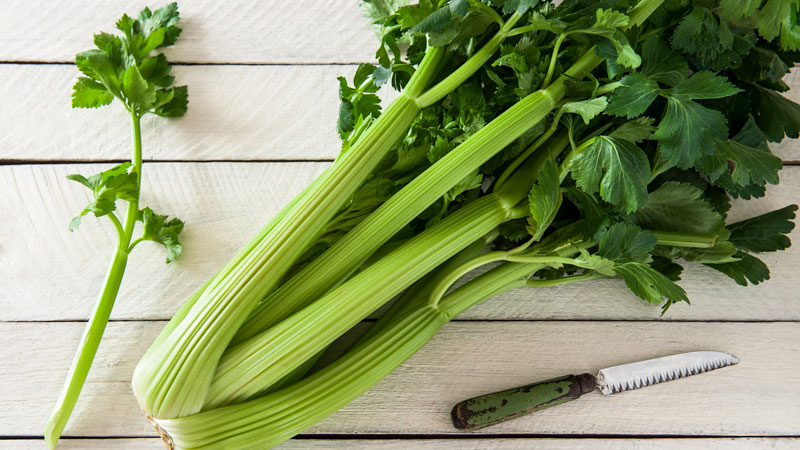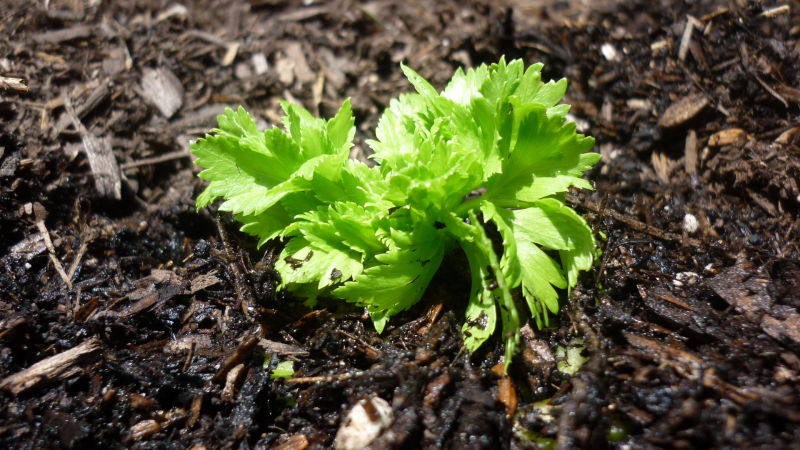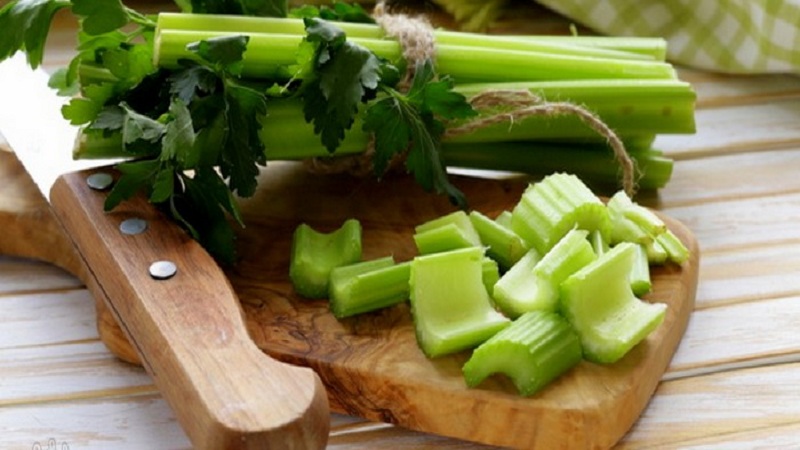How to grow and use stalked celery for maximum health benefits
Petiole celery has a unique set of vitamins, micro- and macroelements, replaces salt in food, removes radionuclides and has a negative calorie content. For processing 100 g of the product, the body spends 25 kcal, while the calorie content of fresh petioles is only 13 kcal.
The culture is whimsical in terms of agricultural technology, but if you follow a number of rules, you will definitely be able to grow and collect a solid harvest at the end of the season.
The article will tell you about the cultivation of a stem variety of celery and its application in cooking, folk medicine and dietetics.
The content of the article
How stalked celery looks and grows
Petiole celery is a biennial plant from the Celery (Umbrella) family with fleshy stems of red, green, pink, white color. In cooking, white petioles with a sweetish taste without bitterness are used. Celery with red stems is frost-resistant down to –5 ° С. Harvested until late autumn.
In the first year, thick petioles up to 1 m high and green fragrant leaves are formed. In the second year, the plant produces arrows with flowers and seeds.
The growing period of stalked celery is 80-180 days, depending on the varietal characteristics.
In the photo - stalked celery.

Features of culture
Rules for the cultivation of stalked celery:
- creating the required level of soil acidity;
- landing on the south side of the garden;
- frequent watering of the beds and control of soil moisture - waterlogging is just as undesirable as water shortage;
- thinning plantings;
- bleaching the petioles to obtain a delicate taste without bitterness;
- fertilizing with fertilizers with potassium and nitrogen.
Why stalked celery is good
Petioles contain easily digestible carbohydrates, vitamins, mineral salts, trace elements, aromatic substances. Regular eating celery has a beneficial effect on metabolism and the central nervous system. The stems are eaten fresh, stewed, boiled, they prepare salads, garnishes for meat, soups.
Composition and nutritional value

The table shows the vitamin and mineral composition of leaf celery per 100 g of product.
| Name | Content | Norm |
|---|---|---|
| Vitamin A | 750 mcg | 900 mcg |
| Beta carotene | 4.5 mg | 5 mg |
| Vitamin B1 | 0.02 mg | 1.5 mg |
| Vitamin B2 | 0.1 mg | 1.8 mg |
| Vitamin B4 | 6.1 mg | 500 mg |
| Vitamin B5 | 0.246 mg | 5 mg |
| Vitamin B6 | 0.08 mg | 2 mg |
| Vitamin B9 | 21 μg | 400 mcg |
| Vitamin C | 38 mg | 90 mg |
| Vitamin E | 0.5 mg | 15 mg |
| Vitamin H | 0.65 μg | 50 mcg |
| Vitamin K | 29.3 mcg | 120 mcg |
| Vitamin PP | 0.5 mg | 20 mg |
| Potassium | 430 mg | 2500 mg |
| Calcium | 72 mg | 1000 mg |
| Silicon | 2.9 mg | 30 mg |
| Magnesium | 50 mg | 400 mg |
| Sodium | 200 mg | 1300 mg |
| Sulfur | 6.9 mg | 1000 mg |
| Phosphorus | 77 mg | 800 mg |
| Chlorine | 26.8 mg | 2300 mg |
| Iron | 1,3 mg | 18 mg |
| Iodine | 7.5 mcg | 150 mcg |
| Cobalt | 0.86 mcg | 10 mcg |
| Manganese | 0.103 mg | 2 mg |
| Copper | 35 mcg | 1000 mcg |
| Molybdenum | 5.4 μg | 70 mcg |
| Selenium | 0.4 μg | 55 mcg |
| Fluorine | 4 μg | 4000 mcg |
| Chromium | 2.1 μg | 50 mcg |
| Zinc | 0.13 mg | 12 mg |
The nutritional value:
- calorie content - 12 kcal;
- proteins - 0.9 g;
- fats - 0.1 g;
- carbohydrates - 2.1 g.
Benefit and harm
Useful properties of stalked celery:
- normalization of intestinal microflora;
- regulation of water-salt metabolism;
- lowering blood sugar levels;
- improved mood;
- elimination of the lack of vitamins and minerals;
- removal of excess fluid from tissues;
- improving sexual function in men and sperm motility;
- relief of unpleasant symptoms of menopause in women;
- reduction of pain during menstruation;
- improving the condition of hair, nails and skin;
- elimination of manifestations of allergies in children and normalization of digestion;
- cleansing of blood vessels;
- elimination of toxins.
Harmful properties:
- increased uterine tone during pregnancy;
- changes in the taste of breast milk;
- worsening of the condition with stomach ulcers and gastritis due to stimulation of the digestive tract.
The product is contraindicated for varicose veins, epilepsy, large kidney stones.
Agrotechnics of culture
Agrotechnology of petiole celery provides for the preparation of seed material, growing seedlings with subsequent picking, transfer to open ground, abundant watering, loosening, weeding, fertilizing and bleaching the petioles.
Seed and soil preparation
Result growing crops depends on the seed. High-quality seeds allow you to grow thick stalks with a pleasant taste and aroma.
When choosing planting material, pay attention to:
- shelf life of seeds - it is advisable not to use material older than 2 years;
- country of origin - seeds of Dutch selection with high yields are considered the best;
- ripening period - it is recommended to give preference to early varieties with a ripening period of 90-100 days.
The planting material is stratified. The seeds are soaked in water at room temperature for 24 hours, then put in a damp cloth and left on a platter of water for 7 days. After the seeds, wrapped in cloth, are placed in the refrigerator for 14-16 days. This procedure increases the germination rate.
For growing seedlings, use a ready-made substrate or prepare a mixture with your own hands.
Mix in a bucket:
- land from the garden, river sand, peat, sawdust (1: 1: 1: 1);
- vermiculite, peat, humus (1: 3: 1);
- humus, wood ash, peat (1: 1: 3);
- sand and biohumus (1: 1).
To disinfect the soil mixture, a hot solution of potassium permanganate or "Fitosporin" is used.
Sowing seeds for seedlings
Washed containers (boxes, plastic trays) are filled with a moist substrate, the seeds are laid out with an interval of 1-1.5 cm to a depth of 5 mm... Sprinkle with peat on top, sprinkle with clean water and stretch polyethylene.
To obtain healthy seedlings, snails are used. A tape 10 cm wide is cut out of dense cellophane or a substrate under the laminate, 1 cm of soil is poured and sprouted seeds are spread with tweezers at a distance of 2 cm from each other and 2 cm from the edge of the film. Then the ribbons are twisted and secured with rubber bands. The snails are placed in wide trays with the seeds facing up and covered with cellophane.
Seedlings are kept in partial shade at an air temperature of + 20 ... + 22 ° C. The film is removed after the appearance of the first leaves, then transferred to a sunny windowsill.
After the appearance of cotyledon leaves, the temperature is reduced to + 12 ... + 16 ° С, and after 10 days it is increased to + 20 ... + 25 ° С. Seedlings with 3-5 leaves dive into individual 300 ml containers. The central root is pinched to stimulate the growth of greenery.
The glasses are filled with soil mixture, formed pits 2 cm, watered with water. Seedlings are carefully poured in with a spoon and transplanted into the holes. Sprinkle on top with soil and watered with warm water.
Reference. The duration of daylight hours for stalked celery is 14 hours, a comfortable air temperature is + 18 ... + 22 ° С.
Seedlings are watered through a sieve 1-2 times a week. "Fitosporin-M" is added to the water to prevent fungal infections. The soil is carefully loosened with a peg, without touching the delicate root system.
Fertilizing seedlings:
- chicken droppings (1 tsp / 3 l of water) - 7 days after the pick;
- nitrophoska (1 tsp / 3 l of water) - every 10 days.
3 weeks before transferring to open ground, the seedlings are hardened on the balcony. The time is increased gradually, starting from 30 minutes. 2-3 days before planting, celery is left in the fresh air overnight.
Outdoor planting and care

Seedlings of petiole celery are transferred after reaching the stems of 20 cm in height.The optimal disembarkation time is the last days of April or early May. The specific dates depend on the weather conditions in the region.
The best soil for growing stalk celery - light sandy loam, fertilized with organic compounds. The culture is planted after cabbage, potatoes, zucchini, cucumbers.
The acidity of the earth is neutral (pH = 6.8–7) or slightly acidic (pH = 5.6–6.0). Celery grows slowly on soils with high acidity. To normalize the pH, dolomite flour, chalk, lime, ash are added.
In the fall, the site is plowed, fed with compost, humus, fermented food waste. In the spring, they re-dig up and loosen, watered with a strong solution of potassium permanganate. On the site, dig holes of 25-30 cm with an interval of 40 cm, observing the distance between the rows - 60 cm. Wood ash is added to the holes.
Seedlings are removed from containers and, together with an earthen clod, are planted in holes. The beds are covered with sawdust or straw to prevent moisture evaporation and delay the growth of weeds.
Care rules:
- the beds are watered 2-3 times a week;
- the soil is loosened after each watering for better aeration of the roots;
- weeding is carried out as needed;
- lateral stems are cut as they grow - thick and strong ones are left, yellow and sluggish ones are removed;
- the plants are fed once a week by alternating potash and nitrogen fertilizers: nitrophoska (25 g / 10 l), urea solution (10 g / 2 l of water), nettle infusion, biohumus.
Disease and pest control
The table contains common diseases of stalked celery and ways to combat them.
| Name | Signs | Treatment | Prevention |
|---|---|---|---|
| Rust | Orange raised spots with spores on petioles and leaves | Fitosporin |
|
| Septoriasis | Yellow spots on greenery, brown-brown spots on the petioles | Fundazol | |
| Cercosporosis | Cream spots 5 mm in size with brown outlines | Topsin-M | |
| Peronosporosis | Whitish bloom on leaves and petioles | Infusion of sow thistle (500 g / 10 l of water) | |
| Cucumber mosaic | Spots in the form of rings of greenery, stunting of stems | The disease is not cured, the infected plants are harvested along with the root and burned |
Stalked celery is affected by carrot flies and bean aphids.
To kill insects:
- celery is planted next to onions;
- sprinkle the plantings with a mixture of mustard powder, river sand, tobacco shag (1: 1: 1);
- water the plants with dandelion infusion (500 g of inflorescences / 10 l of water);
- treat the ground part with infusion of orange or lemon zest (500 g / 5 l of water).
Harvesting and storage
Two weeks before harvest, the petioles are wrapped in cardboard or thick paper for bleaching. Self-bleaching varieties do not need such a procedure; they are cut in September before the arrival of the first frost.
It is not advisable to overexpose the plant on the beds for longer than the prescribed period - 11-16 weeks. Otherwise, the petioles become coarse, fibrous and bitter.
Petiole celery is dug out of the ground and only the roots are cut off. To increase the shelf life and growing, the roots are left and then dropped into wet sand in a cold room.
Product storage methods:
- in a cellar or basement, the stems lie without loss of quality for up to 60 days;
- in the refrigerator - 2-3 weeks;
- in the freezer - about a year, however, the stems lose their taste and dense structure;
- in dried form, celery retains vitamins and minerals, it is used to flavor first and second courses.
How to apply
Petiole celery is actively used in cooking for the preparation of various dishes. Stems are included in the menu for slimming... In traditional medicine, the root and leaves are most often used.
In cooking

Juicy bleached petioles have a delicate taste, do not have bitterness, and go well with fruits, fresh vegetables, poultry and fish.We suggest taking note of a vitamin salad with a spicy soy sauce dressing.
Ingredients:
- petioles - 2 pcs.;
- Peking cabbage - 150 g;
- green apple - 1 pc .;
- carrots - 1 pc.;
- medium-sized orange - 1 pc .;
- green onions - 1 bunch;
- soy sauce - 1 tbsp. l .;
- olive oil - 1 tbsp l .;
- wine or apple cider vinegar - 1 tsp;
- lemon - 1 pc.;
- salt, black or white ground pepper - to taste.
To prepare the salad, cabbage is chopped into thin strips, carrots are chopped on a grater, celery is cut into rings, an orange and an apple are cut into small pieces. Chop the green onions finely and combine all ingredients in a large bowl.
Soy sauce, oil, vinegar, lemon juice, salt, pepper are mixed in a bowl. Season the salad and leave to brew for 15 minutes.
In folk medicine
Petiole celery has medicinal properties:
- relieves inflammation in diseases of the genitourinary system;
- improves digestive function;
- cleans the blood;
- eliminates the signs of allergies.
In case of disruption of the stomach, liver, pancreas, loss of appetite and flatulence, an infusion of dried petioles and root is used. For 1 liter of water, take 1 tbsp. l. raw materials and insist 7-8 hours. Then filter and take 1 tbsp. l. a day after meals.
Tincture of dried stems is effective in treating rheumatism and gout. To prepare it, you will need 500 ml of vodka and 100 g of dried celery. The tool is insisted in a dark place for 2-3 weeks, then used to rub the diseased joints.
Compresses are made from the water infusion at night until the condition improves. Pour 300 g of dried stems into 1 liter of boiling water, cook for 20 minutes, leave for 2-3 hours.
With inflammation of the duodenum, take freshly squeezed juice, 2 tbsp. l. 3 times a day 30 minutes before meals.
Celery decoction is taken with urethritis, cystitis, pyelonephritis. Pour boiling water over fresh petioles and boil for 15 minutes. Then leave to brew for 1-2 hours. The broth is taken in 1 tbsp. a day after meals.
The ointment from the stems treats purulent wounds and skin diseases. The petioles are passed through a meat grinder and mixed with melted butter in equal parts.

Slimming
Petiole celery has a mild laxative and diuretic effect, which makes it indispensable for weight loss. Freshly squeezed juice is used for:
- control of weight indicators;
- general cleansing of the body;
- fight against flatulence and constipation.
Stalk tea is an effective addition to a cleansing diet. It is drunk in the morning on an empty stomach in a warm form in courses of 2 weeks and a break for 30 days.
Drink preparation:
- Wash 3-4 stems, chop finely.
- Boil 1 liter of water.
- Immerse the celery in boiling water and cook for 10 minutes.
- Insist covered for 20 minutes.
To enhance the effect, ginger, lemon and honey are added to the tea.
All vitamins and minerals are preserved in stalk celery juice. The petioles are passed through a juicer and take 100 g of juice in the morning on an empty stomach. To diversify the taste, apple, orange, lemon, carrot juices are added to the drink.
Conclusion
Planting stalked celery for seedlings is the best way to get a rich harvest. This is due to the long growing season of the crop, which depends on the variety and is 80-180 days. Care after planting on the beds: frequent watering, application of organic and mineral fertilizers, weeding, loosening, bleaching of the petioles.
The stems are used for making salads, side dishes, soups. The plant is good for women, men and children. Decoctions, infusions and ointments are prepared from the petioles for the treatment of the genitourinary, digestive systems, rheumatism, gout and skin diseases. The product is irreplaceable in dietary nutrition, has a negative calorie content and removes excess fluid from the body.